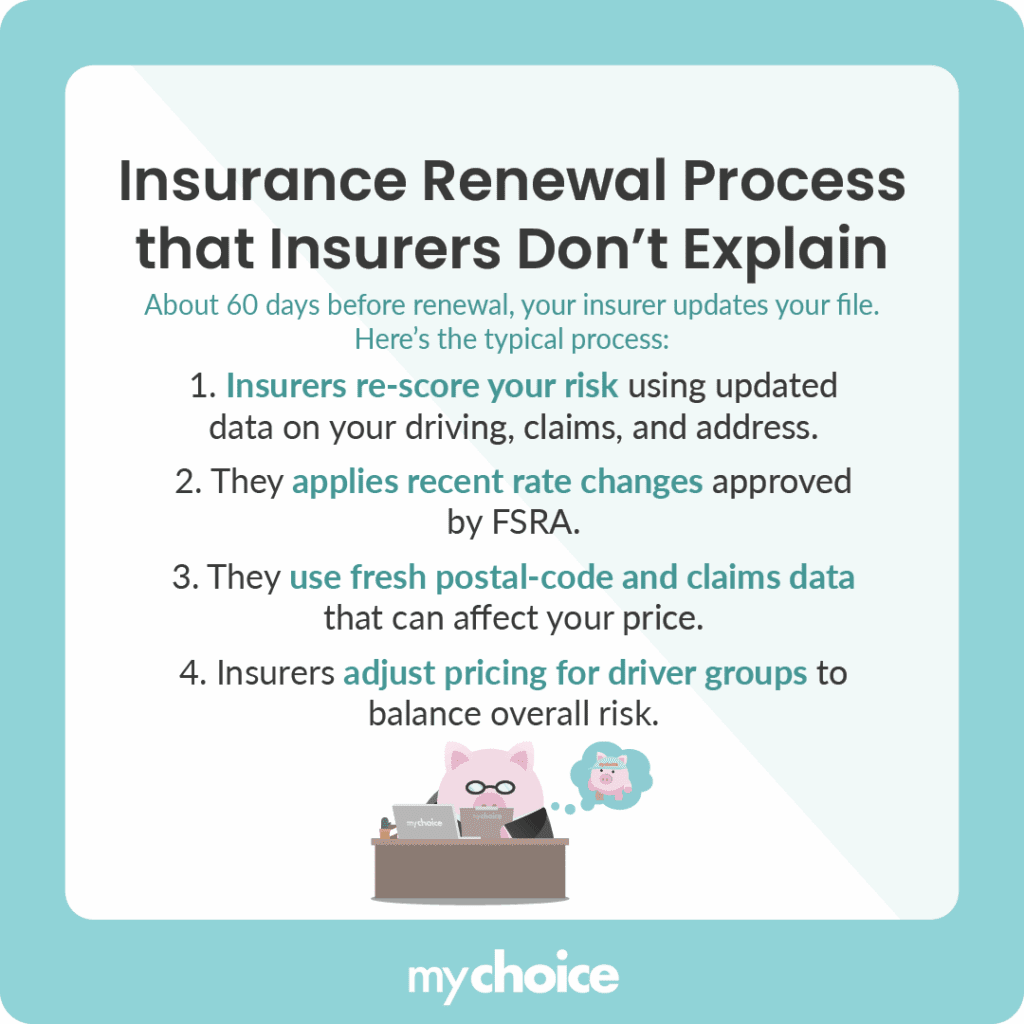If you’ve ever opened your car insurance renewal notice and wondered why your rate went up despite making no claims, you’re not the only one. Your insurance renewal time can surprise you with an increased premium, but it’s also an opportunity to reevaluate your options and try to save money.
Smart drivers use renewal season to shop around, review coverage, and negotiate better rates. Let’s break down what you can do ahead of the renewal to reduce your insurance premiums.
What Actually Happens Behind the Scenes at Renewal Time
About 60 days before your renewal date, most insurers start to do the following:

The Smart Driver’s Renewal Routine (Step-by-Step)
Staying ahead of renewal time means being proactive. Here’s a simple timeline to follow:
| Step | What to Do | Why It Matters |
|---|---|---|
| 45–60 days before expiry | Start comparing quotes with MyChoice or your insurer. | You’ll see if your current insurer is still competitive before your renewal is processed. |
| 30 days before expiry | Review your coverage and discounts. | You may qualify for lower rates if your driving habits or lifestyle have changed. |
| 15 days before expiry | Contact your insurer or broker with questions. | If you’ve found a better quote, your insurer might offer a retention discount to keep you. |
| Renewal day | Confirm your final policy details. | Make sure your policy reflects correct drivers, mileage, and coverages. |
| Post–renewal | Review your documents and save proof of insurance. | Verify your payment schedule and coverage start date to avoid lapses. |
Renewal Is the Best Time to Re-Optimize Your Coverage
Renewal is your once-a-year chance to make sure your coverage still fits your life. A lot can change in 12 months, and even small updates can affect your premium.
| Life Change | Why It Affects Your Rate | What to Do Before Renewal |
|---|---|---|
| Started remote work | Fewer commuting miles can lower your risk rating. | Update your annual mileage and vehicle use (pleasure vs. commute). |
| Moved to a new postal code | Rates vary by area based on accident and theft data. | Tell your insurer right away to ensure your rate is accurate. |
| Added a teen driver | Younger drivers raise risk levels. | Add them to your policy and ask about new driver or graduated licensing discounts. |
| Installed a dash cam or anti-theft device | Some insurers offer discounts for safety features. | Provide proof of installation before renewal. |
| Paid off your car loan | You may not need certain coverages like gap insurance. | Review and remove optional add-ons you no longer need. |
The Renewal “Audit” Checklist
Before you accept your renewal, run through this quick audit to make sure you’re not leaving money on the table:
Why Does Car Insurance Increase at Renewal Even if I Had No Claims?
It’s frustrating, but rate hikes often have little to do with your personal driving record. Here’s why your renewal premium might go up:
- Inflation and repair costs: Car parts and labour have become more expensive, and costs continue to rise every year.
- Increased claims frequency: More traffic and distracted driving mean more accidents overall.
- Severe weather: Flooding, hail, and wildfires are driving up claims across Canada.
- Fraud and litigation costs: Ontario, in particular, faces high costs from insurance fraud and legal claims.
- Regulator-approved rate adjustments: FSRA approves premium increases based on insurer data, not individual drivers.
So even if you’ve had a spotless driving record, these system-wide factors can still raise your rate. That’s why it’s smart to compare and negotiate each year.
How to Negotiate Your Car Insurance Renewal Like a Pro
Are you unsure about how to start negotiating with your insurer for a lower rate? Here’s how to approach it:
When to Switch — and When to Stay Put
Once you receive your new rate and have tried negotiating with your auto insurer, how do you know when it’s time to stay and when it’s time to go? These are some signs you should note:
Key Advice from MyChoice
- Begin comparing rates 45 to 60 days in advance. Insurers often finalize renewal pricing around that time, so you’ll know if it’s worth switching before you’re locked in.
- Always open your renewal notice, compare quotes, and confirm your details before your payment goes through.
- Your lifestyle impacts your rate. If you’ve started working remotely, moved to a new area, installed a dash cam, or paid off your car loan, tell your insurer.








